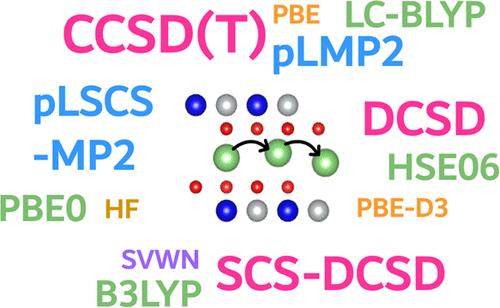当前位置:
X-MOL 学术
›
J. Chem. Theory Comput.
›
论文详情
Our official English website, www.x-mol.net, welcomes your
feedback! (Note: you will need to create a separate account there.)
A Case Study of an Energy Barrier in Li-Ion Battery Cathode Material Using DFT and Post-HF Approaches
Journal of Chemical Theory and Computation ( IF 5.7 ) Pub Date : 2024-11-07 , DOI: 10.1021/acs.jctc.4c01020
Laura Bonometti 1 , Denis Usvyat 2 , Lorenzo Maschio 1
Journal of Chemical Theory and Computation ( IF 5.7 ) Pub Date : 2024-11-07 , DOI: 10.1021/acs.jctc.4c01020
Laura Bonometti 1 , Denis Usvyat 2 , Lorenzo Maschio 1
Affiliation

|
With the ever-increasing interest toward energy storage materials, an accurate understanding of the underlying physicochemical processes becomes mandatory for enabling accurate and predictive simulations. In this study, we apply multilevel quantum chemical calculations on a benchmark material commonly adopted as a cathode in Lithium batteries, Li0.5Co0.5+3Ni0.5+4O2. We estimate the Lithium hopping barrier, a key quantity for the estimate of Li diffusion coefficient, at different levels: Hartree–Fock (HF), density functional theory (DFT), periodic local Møller–Plesset perturbation theory of second order, complemented with a coupled cluster correction evaluated using an embedded-fragment approach. The post-HF methods were used here not only for benchmarking the key quantities themselves but also for assessing the accuracy of different functionals and probing the influence of the long-range and static correlation. For the given system and quantity in question, we observe that obtained results do not significantly vary across different DFT functionals or post-HF methods, which is rather uncommon. Such an agreement between the employed methods suggests that static correlation, even if prominent in this system, cancels out in the studied energy differences. In fact, the values of the T1 diagnostics, which test the reliability of the single-reference description, do vary from one fragment to another. But for certain fragments they are fairly small and of similar magnitude, indicating the applicability of such fragments for the correction. Our best estimate of the reaction barrier is about 0.85 eV.
中文翻译:

使用 DFT 和 Post-HF 方法的锂离子电池正极材料中的能量势垒案例研究
随着人们对储能材料的兴趣日益浓厚,准确理解潜在的物理化学过程成为实现准确和预测性仿真的必要条件。在这项研究中,我们对锂电池中通常用作阴极的基准材料 Li0.5Co0.5+3Ni0.5+4O2 进行了多级量子化学计算。我们估计了不同水平的锂跳跃势垒,这是估计 Li 扩散系数的关键量:Hartree-Fock (HF)、密度泛函理论 (DFT)、二阶周期局部 Møller-Plesset 扰动理论,并辅以使用嵌入碎片方法评估的耦合聚类校正。这里使用的后 HF 方法不仅用于对关键量本身进行基准测试,还用于评估不同泛函的准确性并探测长程和静态相关性的影响。对于给定的系统和所讨论的数量,我们观察到获得的结果在不同的 DFT 泛函或 HF 后方法之间没有显着差异,这是相当罕见的。所采用方法之间的这种一致性表明,静态相关性,即使在该系统中很突出,也会在研究的能量差异中抵消。事实上,测试单一引用描述可靠性的 T1 诊断的值确实因片段而异。但对于某些片段,它们相当小且大小相似,表明此类片段可用于校正。我们对反应势垒的最佳估计约为 0.85 eV。
更新日期:2024-11-08
中文翻译:

使用 DFT 和 Post-HF 方法的锂离子电池正极材料中的能量势垒案例研究
随着人们对储能材料的兴趣日益浓厚,准确理解潜在的物理化学过程成为实现准确和预测性仿真的必要条件。在这项研究中,我们对锂电池中通常用作阴极的基准材料 Li0.5Co0.5+3Ni0.5+4O2 进行了多级量子化学计算。我们估计了不同水平的锂跳跃势垒,这是估计 Li 扩散系数的关键量:Hartree-Fock (HF)、密度泛函理论 (DFT)、二阶周期局部 Møller-Plesset 扰动理论,并辅以使用嵌入碎片方法评估的耦合聚类校正。这里使用的后 HF 方法不仅用于对关键量本身进行基准测试,还用于评估不同泛函的准确性并探测长程和静态相关性的影响。对于给定的系统和所讨论的数量,我们观察到获得的结果在不同的 DFT 泛函或 HF 后方法之间没有显着差异,这是相当罕见的。所采用方法之间的这种一致性表明,静态相关性,即使在该系统中很突出,也会在研究的能量差异中抵消。事实上,测试单一引用描述可靠性的 T1 诊断的值确实因片段而异。但对于某些片段,它们相当小且大小相似,表明此类片段可用于校正。我们对反应势垒的最佳估计约为 0.85 eV。







































 京公网安备 11010802027423号
京公网安备 11010802027423号